16th October 2012
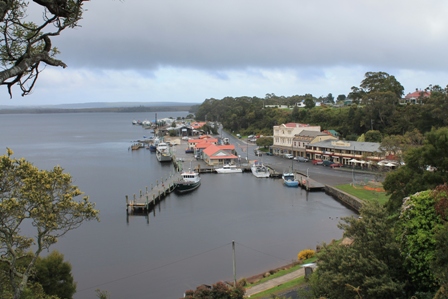
Strahan, northwest Tasmania, 16/10/12 (Dominic Couzens)
After a day of travel we have arrived in Strahan (pronounced “Strawn” as the locals immediately tell you), on the western coast of Tasmania, close to the spot which officially has the cleanest air in the world. An excellent patch of forest close to the town, at Hogarth Falls, allowed us to catch up with our 12th and last Tasmanian endemic, the Black Currawong, which was a satisfying enough statistic for us. There were plenty of other birds here, too, including Tasmanian Thornbill, Crescent Honeyeater and lots of Silvereyes, and we witnessed the spectacular sound of a tree falling in the forest just a few metres away. That display of nature’s dominion was good preparation for a day of driving on one of the world’s most scenic routes, the 100km Western Explorer, formerly known as the “Road to Nowhere”. This road links the mining town of Zeehan with the tiny settlement of Arthur River, and it passes through a vast area of hills, buttongrass mooorland, fast-flowing rivers and temperate rainforest – the largest remaining tract of the latter on earth. The road was for many years uncompleted, hence its unofficial epithet.
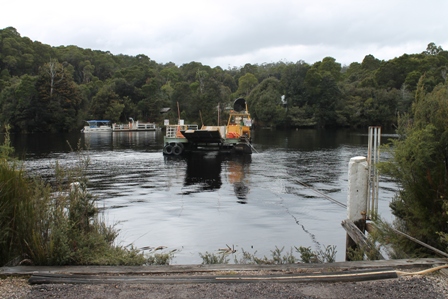
Ferry at Corinna, Tasmania (Dominic Couzens)
If the truth be told, we didn’t see the Western Explorer at its best, because the weather was foul, with consistent rain and wind. The car ferry at Corinna was fun despite the un- expectedly long queue for it, possibly a record: a four-wheel drive ahead of us. With just a handful of vehicles passing each day, you won’t be surprised that there’s no schedule here, you just wave at the ferryman and hope that he is awake. After Corinna you’re pretty much on your own for 80km. Somewhere along that winding, precipitous stretch we saw Blue-winged Parrots by the roadside. These are close relatives of Orange-bellied and Scarlet-chested Parrots in the genus Neophema: pretty much all of them are rare and localised and, therefore, sought after by Aussie birders. While Scarlet-chested Parrots have scarlet chests and Orange-bellied Parrots have orange bellies, guess how you identify this one?
Our main reason for coming to this remote part of Tassie was to try to see the island’s most iconic mammal, the Tasmanian Devil. About the size of a small dog, with an outsize head and with black fur broken up with bright white markings, this animal is the largest of Australia’s magnificent set of carnivorous marsupials. (In contrast to the continent’s famous and much-loved herbivores, such as koalas and kangaroos, you hardly hear anything about such creatures as Quolls – see previous post – and Dunnarts, Antechinuses and Planigales, even though they are every bit as fascinating). You might well have heard that, in recent times, the Devils have been suffering from an infectious facial cancer that has been sweeping through the population, wiping out anywhere between 20% and 50% of the animals present in a given area. With no cure in sight, the authorities have become concerned for this mammal’s very survival, officially upgrading its status in 1990 to Endangered.
The disease has not reached the north-west of Tasmania, and here you can still find the unaffected Devils in reasonable numbers (they are also genetically slightly distinct from the rest). And one of the very best ways to catch up with them is to take a Kings Run
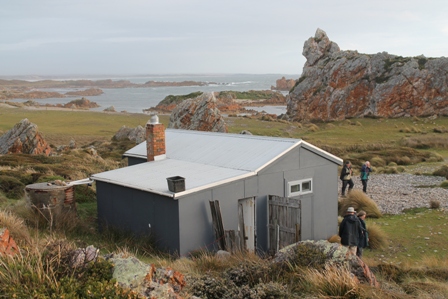
The Shack at King's Run, Tasmania (Dominic Couzens). The food is left out for the Devils next to the top left hand corner of the building.
Wildlife Tour, in which road-killed animals of various kinds (mainly ‘roos) are put out next to an old fisherman’s shack close to the beach of the Southern Ocean, just south of Marrawah. The tours only run for a few nights each month and allow exceptional views of the marsupials down to a few yards – or at least, that’s what we were promised.
First, however, we made a rendezvous in the light with Geoff King along the “main” road north of Arthur River, and found ourselves, not for the first time on this trip, standing on the back of a ute driving over the rough ground down towards the beach. We really had to be disciplined and avoid the temptation of jumping off and chasing a wombat. The location of the shack was simply stunning, as you see from the picture above, and it is hard to convey the sheer isolation of the place. As darkness began to fall Geoff took us on a walk along his beach, looking for birds such as Sooty Oystercatchers, White-fronted Chats, a covey of Brown Quails and thousands of Short-tailed Shearwaters. Along
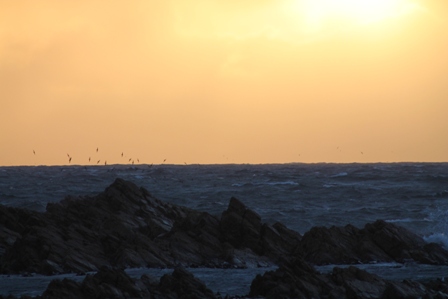
Short-tailed Shearwaters at dusk, Kings Run, Tasmania, 16/10/12 (Dominic Couzens)
the way he told us about the Aboriginal history of the area: after some 40,000 years of settlement, the local Aborigines were convinced peacefully to relocate to Flinders Island, off the Tasmanian coast, where they eventually perished. Geoff showed us some depressions carved out of a flat bed of rocks, where Aboriginal women would wrap themselves in sealskins and lie for hours, not moving, until the fur seals came for a haul-out, whereupon the women would come out from among them and butcher them. He also showed us flintlike rock that the Aborigines used for sharp instruments such as knives. Neither the people nor the seals are here any more.
Darkness fell and we retreated to the shack, excitedly hoping for a visit from a Tasmanian Devil. That wasn’t before we were treated to possibly our most memorable food of the entire trip – abalone chowder. Abalone, if you need reminding, are large, somewhat oyster-like seashells of high culinary worth. They fetch high prices ($50 for a single one) and are a delicacy in many parts of the world, including the Far East. Ours were cooked in a mixture with squid and fish, making a mouthwatering niche concoction, very rich and tasty, washed down with local Tasmanian wines. It is best enjoyed in a small fisherman’s shack, with a roaring open fire, in the company of slightly merry enthusiasts and the prospect of a thrilling evening’s wildlife.
Dead wallaby might not be a patch on abalone chowder, but it worked, and quickly, too. We didn’t have to wait long before Geoff drew back to curtains to reveal the first visiting Tasmanian Devil – a memorable moment. It was just a few metres away and, owing to
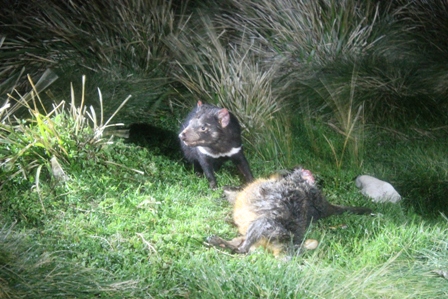
Tasmanian Devil, King's Run, Tasmania, 16/10/12 (Dominic Couzens)
the fact that Geoff had installed a baby listener outside, we could hear its jaws chomping on the bones and meat. With the wind howling and with thickened glass providing a barrier, Geoff was able to give us a running commentary on each animal that visited. Each one is recognisable; we saw three or four younger females. At one point, an individual disappeared underneath the shack and, moments later, there was a volley of devilish howls and screams from below our feet – a confrontation between rivals.
These unearthly sounds are mainly responsible for giving the Devil its name and, believe me, if you were alone in the dark in a Tasmanian shack, you would find them terrifying even if you knew that these animals are harmless to humans. What the early settlers made of them is easy to guess. These marsupials’ diet of predated small animals and larger carcasses to scavenge, together with their hyaena-like mien, has given them a reputation for aggression and violence that, although overstated, is nonetheless one that is likely to stick.
But what an animal!
